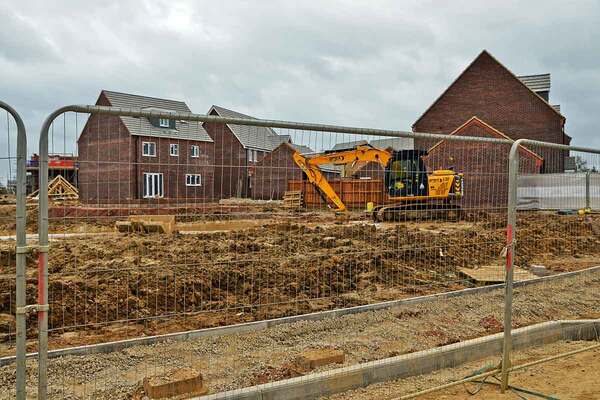Survey: housing leaders’ confidence boosted by new government
Survey of 120 senior housing professionals by Social Housing and Lloyds Bank shows EU referendum has failed to dent the sector’s appetite to build but welfare reform remains the key risk.
Housing association leaders are more confident about the future since the formation of Theresa May’s government, but still rank welfare reform as the biggest risk to their businesses and tenants.
The views are revealed in an exclusive survey of 120 senior housing professionals by Social Housing and Lloyds Bank, one of the sector’s leading lenders.
It found that 44 per cent of people are more confident in the future of the social housing sector since the new UK government was formed, while 37 per cent said their views about the sector were unchanged. Nineteen per cent reported a drop in confidence.
Some respondents pointed out that the May government sees housing associations ‘potentially as part of the solution, rather than part of the problem’, with a feeling there is ‘a better realisation that we need a mixed supply of tenures to meet housing demand’.

Both of these sentiments were reinforced by Chancellor Philip Hammond during his autumn statement in late November, which set out a plan to grant fund a mix of tenures rather than just ownership products.
However, three areas that have not been fully addressed by the new government are also the greatest risks for housing leaders: including welfare reform, the social and affordable rent cut, and applying the local housing allowance cap to social housing.
While the UK’s vote to leave the EU has not impacted build plans, the survey reveals that a third of respondents do not intend to build social rented housing in the next 12 months, with most focused on affordable rent.
Of those that answered, the majority also thought there are too many housing associations in the sector, with a number specifying they believe there are too many inefficient or underperforming organisations.
The results come from research conducted in November 2016 with Lloyds, which has £13bn of lending in the sector.
Respondents were made up of chief executives, finance directors and development directors. A fifth of these were from HAs with 1,000 homes or less, while the majority had up to 20,000 homes and a quarter were groups with more than 20,000 homes.
More than half were based in London and the South East, with a third across the north of England and a quarter from the Midlands, along with respondents from Scotland, Wales and Northern Ireland.
Key risks

Of those surveyed, 74 per cent put welfare reform at the top of the risk register.
As one respondent stated, the biggest risks are now around income and the government’s future policy on welfare reform, while another said a cross-departmental government strategy is urgently needed.
Tony Oakley, head of social housing at Lloyds Bank, welcomed the fact that welfare reform is not being overlooked in light of the many challenges facing UK housing.
‘There is a danger that welfare reform could start to slip off the radar in terms of their risk map because of how long it’s taken to implement, especially with Brexit and other concerns potentially overshadowing that,’ he says.
Sixty-five per cent of respondents also identified the rent reduction as a major risk, followed closely by the LHA cap and then housing policy uncertainty (see chart, below).
Build appetite
Despite that continued policy uncertainty, and the impacts of Britain leaving the EU, the research showed that associations are getting on with the business of delivering new homes.
Most survey participants appear to have healthy development pipelines in place over the next 12 months.
Sixty-four per cent of housing associations are planning to build over 100 units during this period and the majority will deliver up to 500 homes. Around 10 expect to go beyond the 1,000-home mark.
When asked what impact the UK’s vote to leave has had on their build plans, 86 per cent said that it has meant ‘no change’. Only six per cent said they now planned to build fewer homes, whereas eight per cent were unsure.
No one said their building programme was set to increase as a result.
While many will say it is too early to know the real impacts of ‘Brexit’, Mr Oakley warns that associations will need to be increasingly attentive of how negotiations on schemes play out and the ripple effects of the vote on the economy and housing market.
‘If you start to see negative inflation, that I suspect would be the time that they will be particularly mindful,’ he adds.
There are also other more immediate barriers that need to be overcome.
The survey asked which issues, if addressed, would enable associations to deliver more homes. The three key themes were grant funding; availability of land; and the social and affordable rent cut.
The autumn statement was a step in the right direction for grant funding, with a number of associations stating in the immediate aftermath that they would be able to build more with the return to support for rented homes. But questions remain over the capacity in the programme for social rent housing.
One survey respondent said that more grant funding would ‘reduce the need to sell existing housing stock’ in order to cover shortfalls in other parts of the business, and another said it was needed ‘if we want more socialrented homes.’
Another pointed out that the rent reduction merely reduces capacity to build more affordable homes, along with suggestions that there could ‘easily’ be more developments on brownfield land.
Mr Oakley is not surprised that these factors head up housing association concerns on delivery. But other issues could become of greater concern depending on how exit negotiations from the EU proceed.
‘I’m sure as they move forward, the fear may start to increase in terms of skills shortages,’ he says.
Delivery methods
Affordable rent is still the most popular tenure type, with 87 per cent of respondents building these homes.
Almost two-thirds - or 65 per cent - of housing associations plan to build homes for social rent. Clearly, this means a third do not intend to do build social rent. One respondent said that the small amount of social rent they plan to build is limited to the recycled capital grant fund, which was already in the pipeline.
Meanwhile, 79 per cent said they will build shared ownership.
Mr Oakley points to much of the funding from the government’s existing £4.7bn Shared Ownership and Affordable Homes Programme 2016 to 2021 being earmarked for the tenure. There may well be a rebalancing once again on the back of the recent autumn statement announcements.
Fifty-seven per cent of associations said they are developing for market sale in the next year, while almost a third of respondents are planning to build for market rent.
Mr Oakley suggests these results form part of a wider trend for associations in the way they conduct their development plans.
‘What we’re seeing now is this ‘a third, a third, a third’ model, where you’ve got two-thirds of the programme generally allocated to market sale and shared ownership to support development of their social/affordable rent building programme,’ he explains.

Bank finance is the most widely used funding source, with 80 per cent of participants using it to support their development plans. This fits with an ‘uptick in business’ that Lloyds has seen recently, according to Mr Oakley.
While there was a prolonged quiet period in the funding markets from the 2015 summer budget onwards, he says there has been ‘a lot more activity over the last three months’.
Long-term finance in the form of bonds and private placements will continue to play a major role, with 43 per cent of respondents rating it as their most important type of finance. However, Mr Oakley expects housing associations to make the most of the opportunity to ‘mix’ long and short-term finance, enabling them to better manage the uncertainty in the market.
Merger
Interestingly, 70 per cent of respondents plan to use joint ventures to deliver in future, while half of respondents said they intend to use non-registered entities, with a quarter opting for off-balance sheet structures.
Of 97 respondents that answered, 55 per cent said they believe there are too many housing associations. Some added comments clarifying they think there are too many associations that do not ‘sweat their assets’, are under-performing or inefficient. More than a third of them said they are seriously or very seriously considering merger, while almost half said they were not looking at it either seriously or at all.
The key ingredient for merger from respondents was cultural fit, along with a shared purpose and goals. Many also talked about honesty and clarity about the objectives from the outset. Efficiencies and capacity were seen
as important drivers.
Mr Oakley says the needs for those considering a merger will inevitably be complex, but adds that the sector has access to flexible finance and the capital markets.
‘As with any deal, the financial implications and existing agreements need to be carefully considered, and given the mergers that haven’t gone ahead this year, it is good to see that housing associations are also giving prominent thought to culture fit,’ he adds.
This survey was produced in partnership with Lloyds Bank
Related Files
RELATED







